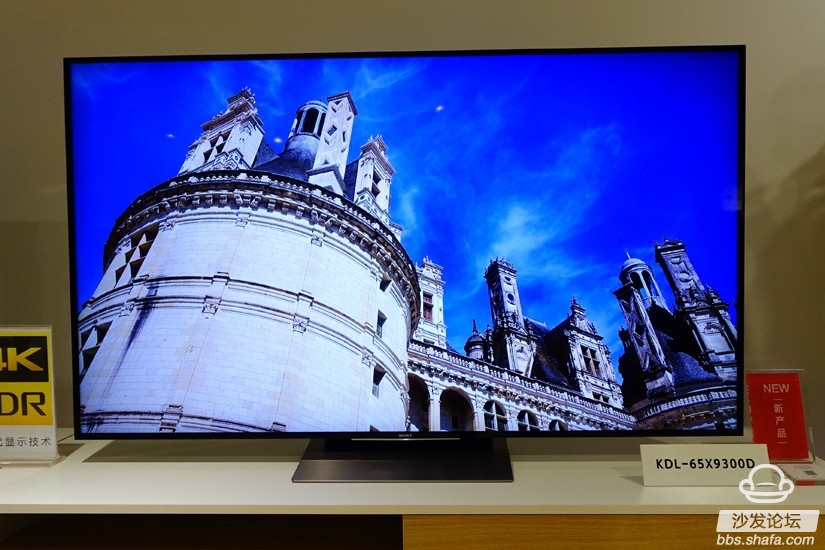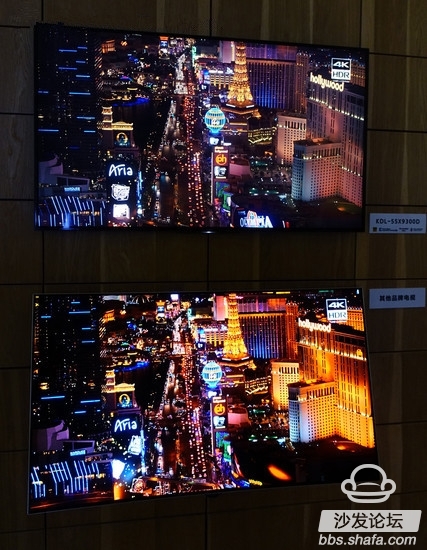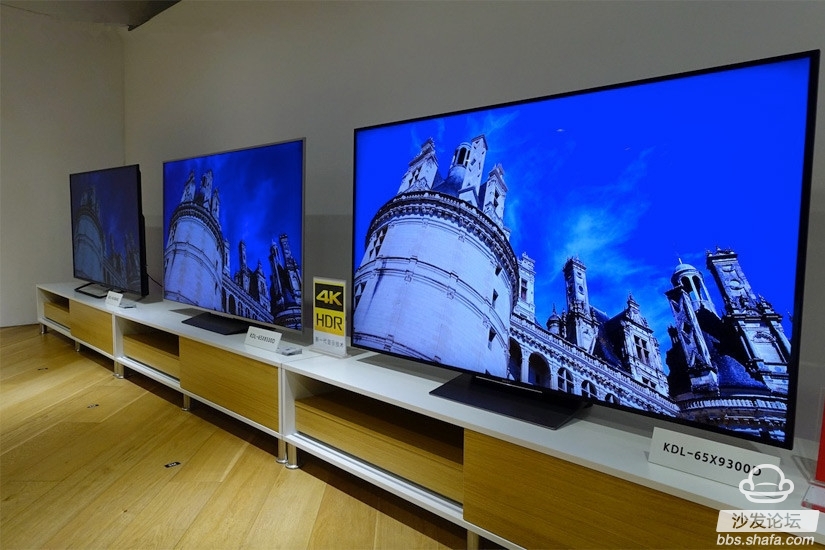The pace of LCD TVs catching up with OLEDs in quality performance has never stopped. The characteristics of self-illumination of OLEDs have undoubtedly brought many congenital advantages. However, from the previous quantum technology to HDR at CES this year, the display level of LCD TVs is also high. It is constantly improving.
As in the 3D and 4K booms that followed, HDR has become the new standard for all major TV sets since 2016. In addition to Sony's 2016 BRAVIA media tasting on February 24, The new X9300D and X8500D series are officially brought into China, and they are directly bringing the new 4K HDR TVs to the same stage as the OLED TVs. This symbolizes that the "black technology" of Sony TVs will once again refresh people's views on LCD TVs.

Why OLED TVs lose to LCD?
The self-illuminating OLED TV seems to have won the battle against LCD TVs. However, when the 4K HDR flagship X9300D was compared with other OLED TVs of its choice, the result was unexpected.
Although the pure black performance of self-illuminating OLED TVs is still a comparable project for LCD TVs, in terms of color reproduction and picture noise control, the selected brands of OLED TVs were defeated in front of the Sony X9300D.
The reason for this, explained by Sony's relevant personnel, is that Sony's experience in displaying color for many years is also reflected in the new 4K HDR product. For the same display screen, Sony can find in the color database accumulated over many years. The most suitable value for human eyes is to present it more accurately on the TV screen. On the other hand, other TV manufacturers often do not have such “big dataâ€.

In addition, the advent of HDR has enabled LCD TVs to reach new heights in OLED strength projects such as display contrast and frame dynamic range. Sony chose to optimize the backlight system to achieve the brightness range that ordinary SDR TVs can easily achieve.
Taking the flagship X9300D series as an example, the Slim Backlight Drive, which is powered by Sony, features a new edge-lit LED backlight structure, which has only one light guide plate compared to the traditional side-entry type. Backlight system elite version of the two light guides can achieve 1 plus 1 more than 2 results, while ensuring the body slim, so that the local control of the backlight area is enhanced, with the elite light control PRO technology, can instantly the brightest picture 3 times the brightness of the area, not only will not let the highlights of the HDR film source overexposure and lose their color details, while the dark areas can also guarantee a darker and distinct, which makes the screen more colorful color levels, more natural color transitions .
HDR Full Industry Chain Advantage Accelerates the Popularization of New Technologies
The complete 4K ecological chain previously owned by Sony was impressive. In the era of HDR, Sony also had the advantage of full industry chain to provide strong support for new technologies.
On the shooting side, Sony has a 4K, 8K camcorder F65 that can record HDR high dynamic range, and an F55 that was involved in the shooting of the monthly pass. It uses a 4K OLED display, and a BVM-X300 monitor with a maximum brightness of 1000 nits in HDR mode. Also sufficient to meet the production requirements of 4K HDR content.

For the TV as a display output, in addition to the above-mentioned Advanced Optical Pro technology, the 4K processing chip X1 that Sony 4K HDR products carry, can drive 4K sharp image processing engine PRO and Terricolor display technology, so that The fusion of large-picture technology further extends the possibilities of 4K HDR's bright and dark expansion and visual expression, presenting more detailed realistic visual performance.
Through the X1 chip driver with Terrific charm and sophisticated light control technology, the Sony X9300D/X8500D series can also increase the dynamic range of common SDR content color and brightness to near HDR effect and alleviate the lack of HDR content. At the same time, the narrow color gamut of the TV signal will be promoted to near the wide color gamut by the Terry charm, and the high-definition video will be promoted to the effect of 4K.
Design + Ease of use welcomes full upgrade
As a leader in global industrial design, a TV is just a screen with outstanding performance. It is obviously not enough for Sony. Compared to its predecessor, Sony injects a slice of Living for 4K HDR TV products. ) The new design concept.
The design idea for wall or desktop placement allows the Sony X9300D to have a wall thickness of only 36.7mm to achieve a more holistic integration with the home wall. The newly added cable management function will include various set-top boxes. The connecting lines of the playing equipment are all hidden in the rear cover of the TV, highlighting the integrated visual effect of the minimalist design.
At the system level, Android TV is a new platform developed specifically for high-definition television. Sony said that "not every Android TV can be called an Android TV," and it is simply based on a TV interface developed on a mobile or tablet computer system. It is difficult to achieve the best fit with TV products, and the good cooperation between Sony and Google also ensures that its TV products can enjoy the continuous update of the latest version of Android TV.

The official retail prices of the currently listed 55-inch and 65-inch X9300D are 14,999 yuan and 2,199 yuan, respectively. The official retail prices for the 55-inch and 65-inch X8500D are 8,999 yuan and 15,999 yuan, respectively, although the price maintains the consistent high-end Sony products. High-end image, but many "black technology" additions and OLED TVs to counter the quality of performance, we can almost look at Sony's new 4K HDR products as the ultimate form of current LCD TVs.
As in the 3D and 4K booms that followed, HDR has become the new standard for all major TV sets since 2016. In addition to Sony's 2016 BRAVIA media tasting on February 24, The new X9300D and X8500D series are officially brought into China, and they are directly bringing the new 4K HDR TVs to the same stage as the OLED TVs. This symbolizes that the "black technology" of Sony TVs will once again refresh people's views on LCD TVs.

Why OLED TVs lose to LCD?
The self-illuminating OLED TV seems to have won the battle against LCD TVs. However, when the 4K HDR flagship X9300D was compared with other OLED TVs of its choice, the result was unexpected.
Although the pure black performance of self-illuminating OLED TVs is still a comparable project for LCD TVs, in terms of color reproduction and picture noise control, the selected brands of OLED TVs were defeated in front of the Sony X9300D.
The reason for this, explained by Sony's relevant personnel, is that Sony's experience in displaying color for many years is also reflected in the new 4K HDR product. For the same display screen, Sony can find in the color database accumulated over many years. The most suitable value for human eyes is to present it more accurately on the TV screen. On the other hand, other TV manufacturers often do not have such “big dataâ€.

In addition, the advent of HDR has enabled LCD TVs to reach new heights in OLED strength projects such as display contrast and frame dynamic range. Sony chose to optimize the backlight system to achieve the brightness range that ordinary SDR TVs can easily achieve.
Taking the flagship X9300D series as an example, the Slim Backlight Drive, which is powered by Sony, features a new edge-lit LED backlight structure, which has only one light guide plate compared to the traditional side-entry type. Backlight system elite version of the two light guides can achieve 1 plus 1 more than 2 results, while ensuring the body slim, so that the local control of the backlight area is enhanced, with the elite light control PRO technology, can instantly the brightest picture 3 times the brightness of the area, not only will not let the highlights of the HDR film source overexposure and lose their color details, while the dark areas can also guarantee a darker and distinct, which makes the screen more colorful color levels, more natural color transitions .
HDR Full Industry Chain Advantage Accelerates the Popularization of New Technologies
The complete 4K ecological chain previously owned by Sony was impressive. In the era of HDR, Sony also had the advantage of full industry chain to provide strong support for new technologies.
On the shooting side, Sony has a 4K, 8K camcorder F65 that can record HDR high dynamic range, and an F55 that was involved in the shooting of the monthly pass. It uses a 4K OLED display, and a BVM-X300 monitor with a maximum brightness of 1000 nits in HDR mode. Also sufficient to meet the production requirements of 4K HDR content.

For the TV as a display output, in addition to the above-mentioned Advanced Optical Pro technology, the 4K processing chip X1 that Sony 4K HDR products carry, can drive 4K sharp image processing engine PRO and Terricolor display technology, so that The fusion of large-picture technology further extends the possibilities of 4K HDR's bright and dark expansion and visual expression, presenting more detailed realistic visual performance.
Through the X1 chip driver with Terrific charm and sophisticated light control technology, the Sony X9300D/X8500D series can also increase the dynamic range of common SDR content color and brightness to near HDR effect and alleviate the lack of HDR content. At the same time, the narrow color gamut of the TV signal will be promoted to near the wide color gamut by the Terry charm, and the high-definition video will be promoted to the effect of 4K.
Design + Ease of use welcomes full upgrade
As a leader in global industrial design, a TV is just a screen with outstanding performance. It is obviously not enough for Sony. Compared to its predecessor, Sony injects a slice of Living for 4K HDR TV products. ) The new design concept.
The design idea for wall or desktop placement allows the Sony X9300D to have a wall thickness of only 36.7mm to achieve a more holistic integration with the home wall. The newly added cable management function will include various set-top boxes. The connecting lines of the playing equipment are all hidden in the rear cover of the TV, highlighting the integrated visual effect of the minimalist design.
At the system level, Android TV is a new platform developed specifically for high-definition television. Sony said that "not every Android TV can be called an Android TV," and it is simply based on a TV interface developed on a mobile or tablet computer system. It is difficult to achieve the best fit with TV products, and the good cooperation between Sony and Google also ensures that its TV products can enjoy the continuous update of the latest version of Android TV.

The official retail prices of the currently listed 55-inch and 65-inch X9300D are 14,999 yuan and 2,199 yuan, respectively. The official retail prices for the 55-inch and 65-inch X8500D are 8,999 yuan and 15,999 yuan, respectively, although the price maintains the consistent high-end Sony products. High-end image, but many "black technology" additions and OLED TVs to counter the quality of performance, we can almost look at Sony's new 4K HDR products as the ultimate form of current LCD TVs.